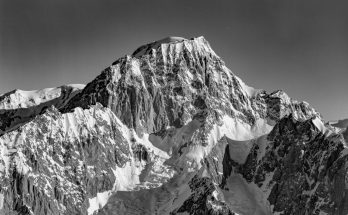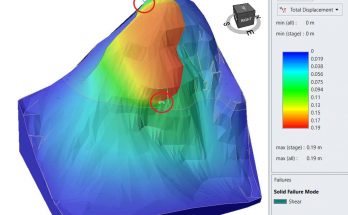Line Rouyet
Co-supervisors: Prof. Michel Jayboyedoff, Dr. Marc-Henri Derron
Experts: Dr. Lene Kristensen, MSc. Clément Michoud
The master thesis named “Monitoring and characterization of rock slope instabilities in Norway using GBInSAR (Ground-Based Interferometric Synthetic Aperture Radar)” aims (1) to improve the knowledge about the advantages and limitations of a GB-InSAR system (©LiSALab-Ellegi) for the monitoring of instable rock slopes; (2) to contribute to the understanding of two large rock instabilities, especially in terms of behavior and geometry.
The work includes (1) the processing and interpretation of GB-InSAR data for two main case studies of major rockslides in Norway, as well as for a third test case involving rockfalls; (2) the comparison of GB-InSAR results with other available monitoring data (GPS, crack/extenso-meters, lasers-reflectors, tiltmeters and meteorological data), as well as the integration of structural analyzes (using Terrestrial and Aerial Laser Scanning data); (3) the global synthesis of the results and the comparison with the conclusions of precedent studies in order to reach the two objectives previously highlighted.
The first case study is the site of Indre Nordnes (Troms County, northern Norway) which is affected by a large rockslide above Lyngenfjord generating a significant risk of tsunami. Its volume is estimated to be around 10-15 millions of m3. Two intermittent GB-InSAR campaigns were performed in summer 2011 and their results are compared and integrated with the large monitoring database available since the end of 2007 for the crackmeters, the beginning of 2010 for the GPS, since mid-2011 for the extensometers and tiltmeters.
Generally, the results show that the rockslide is slow (6-7 mm/year) with accelerations during the thaw periods (May-June). The year 2011 is an exception with an important acceleration in June (up to 14 mm in only 2 weeks according to GB-InSAR data). These values can be related to the exceptionally high temperatures in 2011. Moreover, GB-InSAR data allow giving new information about the extent and the repartition of movements of instable area. Finally, thanks to the structural analyzes two discontinuities sets are supposed to be mainly involved in the sliding. It suggests a stair-steps geometry of the sliding surface.
The second case study is the large Børa/Mannen area (Møre of Romsdal County, western Norway), which includes the rockslide of Mannen (15-25 millions of m3) as well as the Børa plateau located on the southwest side of Mannen. Because Børa area showed some signs of activity, intermittent GB-InSAR campaigns were performed in summer 2011 and 2012. Their results are compared and integrated with the large monitoring database including GPS campaigns between 2003 and 2010 on Børa plateau, various in situ data in Mannen since the end of 2010 and permanent GB-InSAR data since the beginning of 2010. This second GB-InSAR system is located about 2 km more northeastern than the one of Børa and aims to monitor the Mannen rockslide. It has the advantage to be in overlap with the Børa GB-InSAR view and to provide continuous images between 2010 and 2013.
Overall, a good concordance is found between the results of the two GB-InSAR systems. In the overlap part, a coherent and progressive pattern is highlighted in the middle of the slope. During the August 2011 campaign, positive displacements (increasing of distance between the GB-InSAR and the target) are recorded and exceed +8 mm in two weeks. With data integration at long-term, it is shown that this part is affected by large variations and inversions of movements, which can be related to seasons. These effects could be linked to water circulation in the rock slope, but the explanations are not yet clear.
For the Mannen rockslide, it is possible to distinguish two parts with different behaviors in terms of velocities and orientations of movement. It highlights that the most upper and southwestern part is the most active (>20 mm/year). Otherwise, thanks to the structural analyzes three discontinuities sets are supposed to be mainly involved in the sliding.
For Børa area, GB-InSAR recorded higher displacements (25-90 mm/year) than those estimated from GPS campaigns (mainly no significant displacements with a maximum velocity of 14.6 mm/year). In any case, it appears that the area is generally moving slowly and quite regularly.
Finally, high variations at short-term and long-term are visible on the interferograms which cast doubts on the data quality. A case of loss of coherence probably due to snowfalls in October is also detected. This underlines the high potential of researches to improve the removing of atmospheric effects and the capability of the GBInSAR in case of external perturbations.
The third test case of Sunndalsøra-Oppdølsstranda (site C along the road 70 between the two localities, Møre of Romsdal County, western Norway) is studied in order to improve the knowledge of the potential of GBInSAR for the detection and analysis of rockfalls. Between April 2010 and October 2011, five GB-InSAR campaigns were performed and give information about a rockfall event of 15-20 m3 which occurred the 8th of June 2011. The results confirm the capability of the system to record precursor movements to failure, but highlighted also various operational limitations.
Overall, the joined analysis of the three different case studies allows having a good overview of the potential and limitations of the GB-InSAR system. Moreover, because of their respective advantages and limitations (in terms of kind of recorded information, temporal sampling, accuracy, spatial coverage, etc.), it appears that the GB-InSAR and the in situ monitoring devices have a good complementarity. The integration of their results therefore allows giving new inputs about the behavior and geometry of the Indre Nordnes and Børa/Mannen sites.


